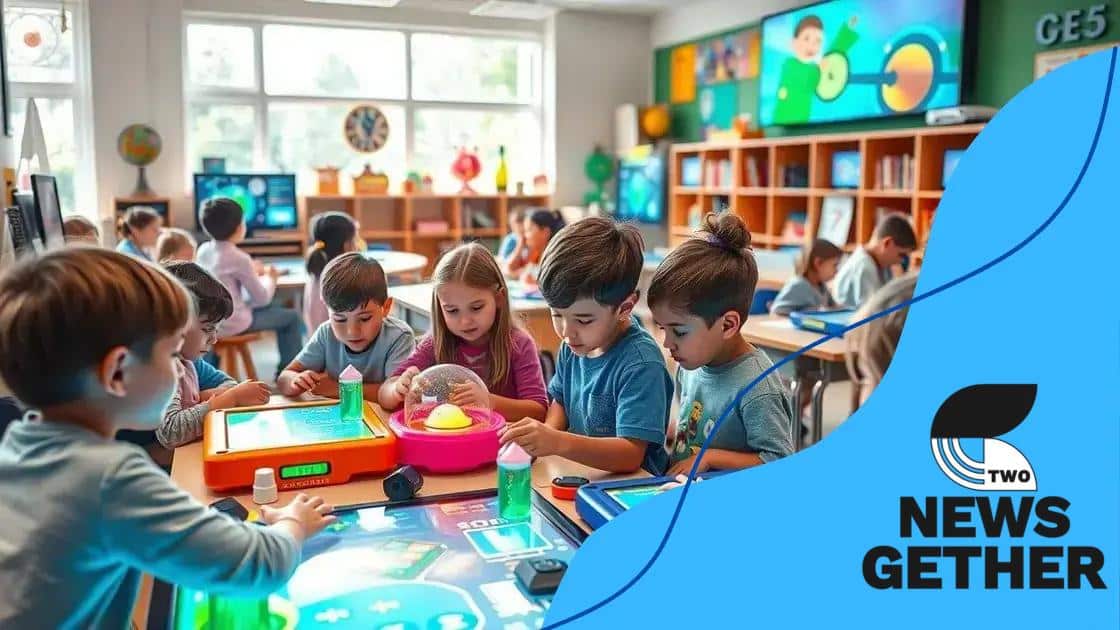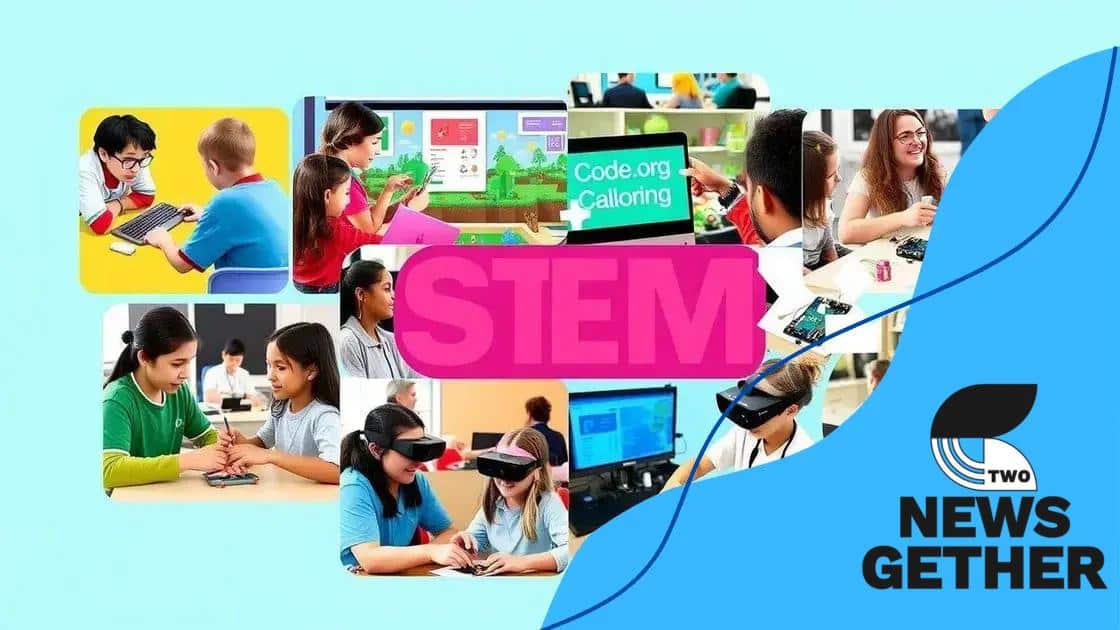Gamification’s influence on STEM education for children

Gamification’s influence on STEM education for children enhances engagement and understanding by integrating game elements into learning, making subjects like science and math more enjoyable and effective.
Gamification’s influence on STEM education for children is reshaping how young learners engage with complex subjects. By incorporating game elements into learning, we can make education not only fun but also effective. Have you ever wondered how game mechanics can capture a child’s attention and enhance their understanding of science, technology, engineering, and math?
Understanding gamification in education
Understanding how gamification works in education is essential for enhancing student engagement. It combines game-like elements with learning tasks, making studying more appealing. This approach taps into students’ natural desires to play and win, motivating them to learn more effectively.
Key Components of Gamification
Gamification integrates several key elements that can significantly improve education outcomes.
- Points: Students earn points for completing tasks, encouraging them to stay focused and motivated.
- Badges: Badges can symbolize achievements, providing recognition and a sense of accomplishment.
- Leaderboards: These foster healthy competition, pushing students to do their best.
- Challenges: Fun and educational challenges can promote problem-solving skills.
By implementing these components, educators can create a rich learning environment. The competitive nature instilled by gamification can turn a boring subject into an exciting challenge. Students might find themselves drawn into a world where math equations feel like quests, and science experiments become exciting adventures.
How Gamification Enhances Learning
When students engage with gamified elements, they often experience improved focus and retention. The interactive nature of games keeps students interested and less likely to disengage. Furthermore, as they navigate through challenges, they develop critical thinking skills that are essential for their future.
This educational strategy encourages collaboration among classmates. Working together to solve puzzles or achieve shared goals fosters teamwork and communication skills, which are vital in today’s world.
Benefits of gamification in STEM learning
The benefits of gamification in STEM learning are vast and impactful. By using game elements in educational settings, students can enjoy a more engaging and effective learning experience. This innovative approach can motivate students and enhance their understanding of complex subjects.
Increased Engagement
One of the main advantages is increased engagement. When students participate in gamified lessons, they are more likely to focus and participate actively.
- Interactive learning: Game mechanics encourage students to interact with the material, leading to deeper understanding.
- Fun environment: Gamified settings create a fun atmosphere that reduces anxiety, making learning enjoyable.
- Motivation: Rewards and challenges spur motivation, encouraging students to reach their goals.
Furthermore, gamification can help students retain information longer. Through fun challenges and quests, they can practice skills repeatedly without feeling like it’s a chore. As they solve problems and gain rewards, they build confidence in their abilities in subjects like science and math.
Enhanced Collaboration
Another benefit is enhanced collaboration among students. Gamification often involves teamwork and communication, essential skills in today’s world. Working together on projects or challenges allows students to learn from one another.
During these activities, students can also develop critical thinking and problem-solving abilities. As they face obstacles in the game, they learn to think creatively and strategize effectively, skills that are crucial in any field.
The integration of these elements not only makes STEM subjects more appealing, but also prepares students for future challenges, equipping them with skills they can use in real-life situations.
Examples of successful gamified STEM programs

Examples of successful gamified STEM programs show how effective this approach can be in educational settings. These programs not only enhance learning but also make it more enjoyable for students. Many educators around the world have embraced gamification, and here are some notable examples.
1. Code.org
Code.org is a platform that introduces coding concepts through fun games. Students learn to code by completing levels that resemble popular games. As they progress, they develop crucial programming skills while staying engaged. This platform attracts millions of students, making coding accessible and exciting.
2. Minecraft: Education Edition
Minecraft: Education Edition transforms learning into a playful environment where students can create their worlds. In this gamified space, students explore subjects like math and science through building and problem-solving. For example, they can simulate ecosystems, learning about biology while crafting their environments.
3. Kahoot!
Kahoot! uses game-based quizzes to make review sessions interactive. Teachers can create quizzes that allow students to compete in real-time. This encourages friendly competition and boosts motivation. As students answer questions correctly, they earn points, fostering a fun learning atmosphere.
4. zSpace
zSpace offers virtual reality (VR) experiences in STEM education. Students can interact with 3D objects in a virtual space, making complex subjects tangible. For instance, they can dissect virtual organisms or manipulate molecular structures, making biology and chemistry more accessible and engaging.
5. Pi-Top
Pi-Top combines coding and creative design by offering a computer kit that students can build. As they assemble the device, they learn about technology and engineering. Pi-Top encourages students to tackle real-world problems through their projects, fostering innovation and creativity.
These examples show how gamification can turn traditional STEM education into engaging experiences. By applying game elements, students are not just learning; they are having fun and becoming active participants in their education. Schools can use these ideas to inspire their programs, creating environments where learning thrives.
Challenges in implementing gamification
Implementing gamification in education faces several challenges that educators need to navigate. While the benefits are clear, the journey to integrating game elements into the classroom can be complex. Understanding these challenges allows for better preparation and adaptation.
Lack of Resources
One significant challenge is the lack of resources available for teachers. Many educators may not have access to the technology or tools needed to implement gamified lessons effectively.
- Technology barriers: Schools can struggle with outdated equipment, making it difficult to use advanced game-based tools.
- Limited training: Teachers might not receive training on how to effectively incorporate gamification into their teaching practices.
- Funding challenges: Establishing a gamified program can require additional funds for software or materials.
When schools lack the necessary resources, implementing gamification may feel overwhelming. It can also lead to inconsistency in the quality of education that students receive.
Resistance to Change
Another challenge is resistance to change among staff or administrators. Some educators may worry about shifting from traditional teaching methods to more interactive ones. This resistance can stem from various factors, including fear of the unknown and a lack of familiarity with gamification principles.
Additionally, changing the mindset of educators is essential. Many may view learning as a serious process and believe that games may undermine academic rigor. Overcoming these perceptions is crucial for successful implementation.
Student Readiness
Not all students are ready for gamified learning experiences. Some may struggle to adapt to new methods of engagement. While gamification works well for many, others might find it challenging to focus or participate effectively.
Every student learns differently, and educators must consider these differences when designing gamified experiences. Customizing lessons to address various learning preferences can make a significant difference in overall success.
As schools begin to embrace gamification, they must address these challenges head-on. By understanding potential obstacles, they can create strategies to make the integration process smoother and more effective.
Future trends in gamification and education
Future trends in gamification and education promise to reshape learning experiences for students worldwide. As technology continues to advance, educators are finding innovative ways to incorporate game mechanics into their teaching methods. This evolution not only engages students but also personalizes their learning journeys.
Increased Use of AI
One trend is the increased use of artificial intelligence in gamified learning. AI can tailor educational content to meet individual students’ needs. For example, adaptive learning platforms can assess student performance in real-time and offer challenges that are just right for their skill levels.
- Personalized learning paths: Students will follow unique paths based on their progress and interests.
- Instant feedback: AI can provide immediate feedback on tasks, allowing students to adjust their strategies quickly.
- Enhanced engagement: Tailored experiences will maintain student interest and motivation.
This evolution can foster a deeper understanding of STEM subjects and help students appreciate their relevance in daily life.
Virtual and Augmented Reality
Another exciting trend is the incorporation of virtual and augmented reality (VR and AR) into educational settings. These technologies can create immersive learning environments where students can explore complex scientific concepts in a hands-on way.
Imagine students walking on Mars in a VR simulation or manipulating 3D models of molecules with AR tools. These experiences can enhance learning and retention by making abstract concepts more tangible.
Collaborative Learning Platforms
The future will also see the rise of collaborative learning platforms that integrate gamification. These platforms will allow students to work together on projects in a fun and engaging format. Team-based challenges can foster teamwork and communication skills while making learning more enjoyable.
Through these platforms, students can compete in friendly competitions, share knowledge, and celebrate achievements together. This promotes a sense of community and belonging within educational settings.
As gamification continues to evolve, it holds the potential to create richer, more engaging educational experiences. The integration of new technologies will help educators connect with students better, making learning more meaningful and relevant.
FAQ – Frequently Asked Questions about Gamification in Education
What is gamification in education?
Gamification in education involves using game elements in learning environments to enhance engagement and motivation among students.
What are some benefits of using gamification in STEM learning?
Gamification can increase student engagement, improve knowledge retention, and promote skills such as teamwork and problem-solving.
What challenges might educators face when implementing gamification?
Challenges include resource limitations, resistance to change, and varying levels of student readiness for gamified experiences.
What tools can educators use for gamification?
Educators can use platforms like Kahoot!, Code.org, and Minecraft: Education Edition to implement gamified learning activities effectively.






